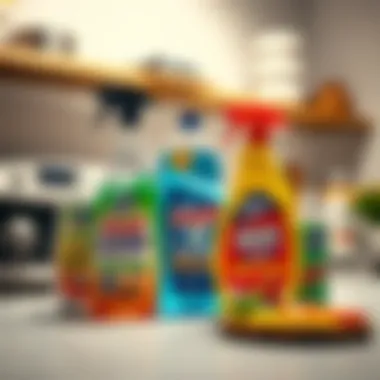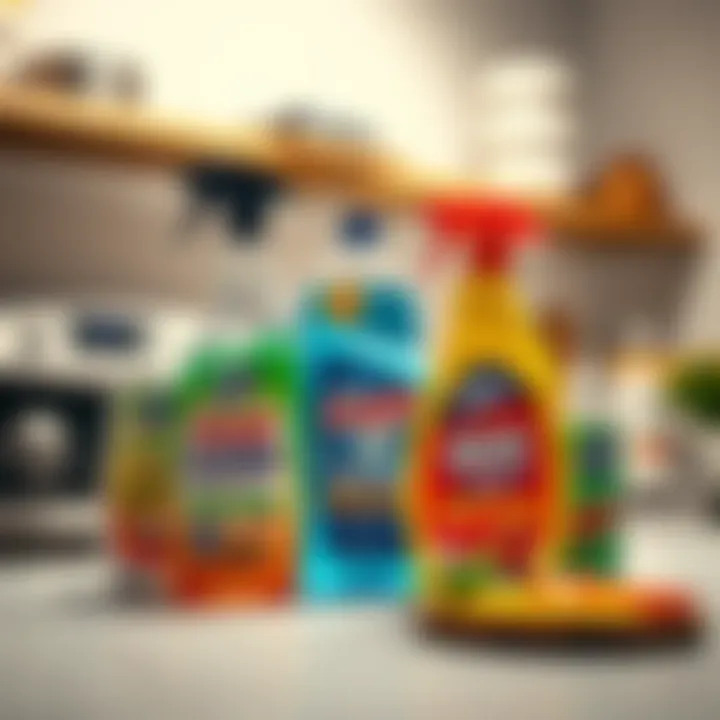Top Techniques for Cleaning Grout in Ceramic Tile


Intro
Ceramic tiles have long been a favorite for flooring and wall coverings due to their durability and aesthetic appeal. However, one area that often becomes a pain point in maintaining these beautiful surfaces is the grout lines. Grout is the glue that holds tiles together, but over time it can become discolored and grimy. Understanding how to effectively clean grout lines is not only essential for keeping your tiles looking fresh but also for preventing mold and bacteria growth.
This guide dives into the nitty-gritty of grout cleaning, exploring a variety of methods that blend both natural and commercial solutions. Grout lines, often overlooked, can drastically change the overall look of your tiled surfaces when neglected. If you find yourself unearthing stubborn stains or greyed-out grout that used to be bright white, fret not. From simple household items to robust commercial cleaning agents, we will cover groundbreaking approaches to tackle those pesky grime-filled crevices.
Whether you're gearing up for a major overhaul or just need a little touch-up, our methods range from basic maintenance to in-depth cleaning operations. Moreover, we'll throw in some valuable tips on prevention, emphasizing that an ounce of prevention is worth a pound of cure. By addressing both cleaning techniques and maintenance strategies, you'll be well on your way to achieving a clean and pristine grout line.
Get ready; you’ll learn how to restore the shine of your ceramic tiles while crafting a cleaner, healthier living space.
Understanding Grout and Its Importance
Grout is often underestimated when it comes to tile installation and maintenance. Many homeowners might think it’s just some filler between the tiles, but in reality, it plays a crucial role not just in aesthetics but in the overall integrity of your tiled surfaces. To fully grasp cleaning methods, one must first understand what grout is and why it’s essential in tile applications.
What Is Grout?
Grout is a mixture of water, cement, and sometimes sand that fills the gaps between tiles in various flooring and wall applications. When you observe those thin lines between your tiles, that's grout doing its job. It creates a barrier that keeps dirt and other debris from infiltrating those spaces. However, grout isn’t merely a functional filler; it also serves as a craftsperson’s tool to set the aesthetic tone of a tiled surface. The choices can be broad, ranging from colors that harmonize to stark contrasts meant to emphasize design.
The Function of Grout in Tile Installation
The primary function of grout is to ensure stability in the tile arrangement. Think of it as the glue that holds your tiles together. Without grout, tiles could potentially shift, leading to cracks and loosening. Furthermore, grout prevents water from seeping underneath the tiles, which can lead to serious moisture problems like mold and mildew. This aspect is especially critical in areas such as kitchens and bathrooms where water exposure is frequent. Beyond just practicality, grouts can showcase the artistic flair of an installation; varied colors and textures can turn a plain tile layout into a visually striking feature.
Types of Grout Used in Ceramics
When discussing types of grout used in ceramics, it's important to note several variations that suit different situations:
- Unsanded Grout: This option is smooth and often used in tighter joints. It’s perfect for delicate tiles that might get scratched by sanded varieties.
- Sanded Grout: As the name implies, this type contains sand, providing extra strength for wider joints. It’s designed to resist cracking and is commonly used for floors.
- Epoxy Grout: Known for its water and stain resistance, epoxy grout is a durable option suitable for both high-traffic areas and wet environments.
- Flexible Grout: This is a more recent innovation that offers enhanced flexibility, mitigating issues caused by the natural expansion and contraction of the surrounding materials.
"Understanding the properties and function of different types of grout can lead to better decisions in both maintenance and cleaning strategies."
In summary, comprehending grout’s core functions is crucial not only for tile installation but also for subsequent cleaning and maintenance. A well-informed approach to grout care leads to longer-lasting, visually appealing tiled surfaces. It's the foundation upon which the charm of any tiled space rests.
Common Challenges in Grout Maintenance
Maintaining grout lines in ceramic tiles is no walk in the park. While they may seem like a small part of the overall tile installation, their upkeep is essential to ensure that your tiled surfaces remain aesthetically pleasing and functional. When considering the challenges that come with grout maintenance, it's crucial to focus on key factors, such as stains, mold growth, and general wear and tear. Understanding these elements can make all the difference in achieving a clean and lasting finish.
Understanding Stains and Discoloration
Grout stains and discoloration can be a persistent problem. From food stains in kitchens to mud marks in entryways, it's easy for grout to accumulate dirt and grime, losing its original charm. Factors contributing to grout discoloration include the type of grout used, exposure to moisture, and the materials used for cleaning. Regular cleaning can help mitigate these issues, but it's essential to know that stains can settle in over time. Using the wrong chemicals can sometimes make it worse, pushing dirt deeper into the porous material. Therefore, being well-informed about suitable cleaning methods will serve as the first line of defense against these unsightly marks.
Mold and Mildew Growth
Ah, mildew — that unwelcome guest that seems to pop up when you least expect it. Grout lines, being porous, often serve as a breeding ground for mold and mildew in damp areas like bathrooms and kitchens. To catch these growths before they flourish, you should regularly inspect grout lines for any dark spots or musty odors. Ignoring these problems not only affects the aesthetic of your tiles but can also lead to significant health concerns in the long run.
Prevention is better than cure is particularly relevant here. A well-ventilated space and prompt cleaning after spills can help reduce moisture levels, thus lessening the chance of mold and mildew taking root.
Wear and Tear Over Time
Grout, while durable, doesn’t last forever. Over time, exposure to foot traffic, cleaning products, and even just the passage of time can lead to cracks and discoloration. This wear and tear can turn even the most pristine tile job into a sorry sight. Forgetting to address these issues can eventually lead to more significant and costly repairs if the integrity of the grout is compromised.
As every homeowner knows, maintaining a regular cleaning schedule not only ensures that stains and mildew are kept at bay but also helps to extend the life of the grout.
In summary, recognizing and addressing these common challenges is key to grout maintenance. Keep an eye out for stains, mold, and signs of wear. A proactive approach will keep your tile installations looking vibrant and new, adding lasting beauty to your spaces.
Homemade Solutions for Grout Cleaning


Cleaning grout lines can feel like an uphill battle. However, those seeking alternatives to commercial cleaners might find that homemade solutions can be just as effective, if not better. One of the primary benefits of choosing homemade solutions is their accessibility; most of the ingredients needed are likely already sitting in your pantry. They are also much gentler on both the environment and your tile surfaces compared to harsher chemicals. This section explores several DIY methods that promise clean and fresh grout without breaking the bank or introducing toxic substances into your home.
Baking Soda and Vinegar Method
A classic combo often found in many kitchens, baking soda and vinegar form a powerhouse duo when it comes to removing dirt and stains from grouted surfaces. This method's appeal lies in its simplicity.
- How It Works: Baking soda acts as a gentle abrasive, perfect for scrubbing stubborn stains, while vinegar's acidity helps break down grime. When combined, these two create a fizzy reaction that can lift dirt straight out of those pesky grout lines.
- Steps to Use:
- Considerations: Always test this method in a small, hidden area to make sure it doesn’t affect your tile finish. And remember, patience is key—there’s no need to rush through the scrubbing process.
- Sprinkle a generous amount of baking soda directly onto the grout lines.
- Spray a mixture of equal parts water and white vinegar over the baking soda.
- Let it sit for about 10 to 15 minutes. You'll notice some bubbling – that's a good sign!
- Scrub the area with a soft-bristled brush or an old toothbrush.
- Rinse with warm water to remove any residue.
Hydrogen Peroxide Use
Another effective homemade cleaner is hydrogen peroxide. Its natural bleaching properties make it particularly useful for whitening grout without the use of harsh chemicals.
- How It Works: Hydrogen peroxide can penetrate dirt and stains effectively, helping to lift them away from grout lines. Plus, it acts as a mild antiseptic, which is beneficial for areas prone to mold and mildew.
- Steps to Use:
- Considerations: This method is potent, and while generally safe for most surfaces, it is advisable to avoid using it on colored grout, as it could potentially lighten the hue.
- Pour hydrogen peroxide directly onto the stained grout.
- Let it sit for about 20 minutes, allowing it to do its magic.
- Scrub with a brush suitable for your tiles. Pay extra attention to particularly stained areas.
- Rinse thoroughly with water.
Essential Oils for Freshness
Not only do essential oils smell great, but they can also play a role in grout cleaning. Natural oils like tea tree and lavender come with antifungal properties, making them perfect for combating mold and mildew buildup.
- How It Works: These oils not only leave a pleasant scent but also help keep your mold problems at bay. Pairing them with a base like baking soda or vinegar can increase their effectiveness.
- Steps to Use:
- Considerations: When using essential oils, quality matters. Opt for pure, therapeutic-grade oils to ensure maximum effectiveness.
- Mix a few drops of your preferred essential oil with a cup of warm water.
- Spray the solution onto the grout lines.
- Allow it to sit for at least 15 minutes.
- Scrub and then rinse with water.
Remember, regular maintenance is key to keeping your grout lines clean. Investing some time into these homemade methods can save you a lot of hassle down the line.
Commercial Cleaning Products for Grout
When it comes to keeping grout lines in ceramic tiles looking spick and span, commercial cleaning products play a pivotal role. They offer robust cleaning power that often surpasses homemade solutions, particularly when dealing with stubborn stains or significant mold build-up. The main appeal of these products lies in their formulation, which is tailored to address specific issues — from discolored grout to persistent dirt. Specific elements such as scent, ease of application, and concentrated formulas add to the allure. However, being savvy about your choices is crucial, as not all products are created equal.
Choosing the Right Product
Selecting a suitable commercial grout cleaner can feel like looking for a needle in a haystack, given the myriad of options available. Here are some pointers that can guide your decision:
- Identify the Grout Type: Not all grout is the same; some are more porous than others. Ensure the cleaner is compatible with your grout type — whether it be sanded, unsanded, or colored.
- Read Ingredients Carefully: Look for products that contain less abrasive chemicals if you're concerned about damaging the tile or grout. Some cleaners contain bleach, which may discolor colored grout.
- Consider Usage Conditions: If you’re dealing with mildew, search for products specifically designed for that issue. A cleaner formulated for bathrooms may not be effective for kitchen grout.
- Check for User Reviews: This is where you can tap into the experiences of others. Sometimes a product may sparkle on the shelves but falls flat in real-world applications. Search through reviews on platforms like Reddit or product-specific forums.
Evaluating Effectiveness of Products
Once you've purchased a commercial cleaner, assessing its effectiveness becomes the next step. Here are some practical ways to determine if it's doing its job:
- Test in a Small Area: Always do a patch test in an inconspicuous area. If you see no adverse reactions and the results are satisfying, you’re good to go.
- Time Sensitivity: Most products come with guidelines about how long to leave them on before scrubbing. Following these instructions closely is key to maximizing results.
- Check Residue: After rinsing, look for any remaining film or residue. If the grout continues to look dusty or discolored, it’s time to reconsider your choice.
"An ounce of prevention is worth a pound of cure." A little diligence in choosing the right product now can save you from future headaches.
Safety Precautions When Using Chemicals
Working with commercial cleaning products does come with its share of risks. Taking safety precautions ensures you have a smooth experience while keeping the space safe for everyone. Here are some essential tips:
- Read Labels Thoroughly: Always read the instructions and safety warnings before diving in.
- Ventilation is Key: Open windows or use fans to ensure proper ventilation while using harsh chemicals. This helps in reducing inhalation risks.
- Protective Gear: Donning gloves and goggles can prevent skin irritation and eye contact with potentially harmful substances.
- Store Wisely: Keep these products out of reach of children and pets. Accidents can happen in the blink of an eye.
By understanding these facets of using commercial cleaning products for grout, individuals can streamline their cleaning process, ensuring both effectiveness and safety. Educated decisions lead to a more successful grout cleaning experience, leaving floors looking fresh and inviting.
The Cleaning Process: Step-by-Step
When it comes to cleaning grout lines, a well-structured approach is vital. The cleaning process should not be viewed as a mere chore; rather, it’s an art that requires precision and attention to detail. A systematic method ensures that not only do you achieve spotless results, but you also protect the integrity of the grout and surrounding tiles. The steps outlined below will equip you with practical techniques to preserve and revitalize your tiled surfaces.


Preparation for Grout Cleaning
Before diving into the cleaning phase, preparation is key. Make sure to gather all the necessary tools and supplies. Here’s what you will generally need:
- Brushes: A toothbrush or a stiff-bristled brush will be adequate.
- Cleaning solution: Choose between commercial products or homemade mixtures.
- Protective gear: Gloves and goggles to keep yourself safe from chemicals.
- Bucket: For mixing solutions and rinsing brushes.
- Rags or sponges: For wiping surfaces and drying.
After assembling your tools, it’s crucial to clear the area of any furniture or items. This allows you to work without hindrance and ensures you can get every nook and cranny without missing a spot. Don’t forget to ventilate the space if you’re using strong cleaning solutions, particularly those involving bleach or ammonia. Taking these steps helps set the stage for an effective cleaning experience.
Applying Cleaning Solutions
Now that you’re set up, it’s time to apply your chosen cleaning solution. If you favor a cleaner from the store, read the instructions carefully. Each product has its own recommended method of application. However, if you opt for a homemade solution, a common recommendation is a mixture of equal parts baking soda and vinegar. This dynamic combo creates a fizz that can loosen grime effectively.
- Apply evenly: Use a spray bottle for an even distribution or apply with your brush directly.
- Let it sit: Allow the solution to sit for a few minutes. This is essential as it gives the cleaner time to penetrate the stains.
- Do a patch test: It's wise to test the solution on a small area first to ensure it won't damage the tile or grout.
By taking these precautions, you’ll ensure that the solution works effectively without causing any unwanted damage.
Scrubbing Techniques for Maximum Results
Once the solution has had time to work its magic, it’s scrubbing time. Employing the right technique can make a world of difference:
- Choose the right brush: Depending on the level of dirt, choose a brush with tougher bristles for stubborn stains.
- Angles matter: Scrub at a 45-degree angle to both agitate and lift away grime without causing scratching.
- Work in sections: Tackling one small area at a time makes it easier to monitor progress and results.
- Use consistent pressure: Apply even pressure while scrubbing, ensuring thorough cleaning without overdoing it.
In this stage, you may find yourself transforming not just the grout but the overall appearance of your tiled surfaces, making it a satisfying endeavor.
Rinsing and Drying the Area
Once scrubbing is complete, rinsing is the final yet significant step. This part cannot be overlooked. Leftover cleaning solutions can harm grout, leading to more stains or damage down the line. Here’s how to ensure proper rinsing:
- Use clean water: Rinse your brushes with clean water, and refill your bucket. Water should be warm to help dissolve any remaining residues.
- Wipe down the area: Using a clean rag or sponge, wipe the area down thoroughly to remove any remnants of the cleaning solution.
- Dry the surface: After rinsing, dry the tiles and grout with a dry towel or let the area air dry. High humidity might prolong the drying time and can invite mold growth if not dried well.
Finally, standing back to admire your handiwork pays off. Your efforts result in revitalized grout lines that contribute to an inviting atmosphere in your home. Following this step-by-step process ensures a systematic and effective deep clean, enhancing both the aesthetics and longevity of your ceramic tiled spaces.
Preventive Care for Long-Lasting Grout
Taking care of grout isn't just about removing stains after they appear; it’s about establishing a proactive approach. Preventive care is essential for ensuring that your grout lines remain pristine over time. With proper care, you'll not only save yourself from hours of scrubbing later on, but you’ll also maintain the overall aesthetic and value of your tiled surfaces.
Regular maintenance and preventive measures can significantly reduce the potential for permanent stains, mold growth, or degradation of the grout material. Implementing a systematic approach can extend the life of both your grout and tiles, making this a vital part of home care.
Regular Maintenance Schedule
Establishing a regular maintenance schedule is a cornerstone of grout care. Think of it as the difference between tending to a garden versus waiting for the weeds to take over. A consistent routine can help you manage the cleanliness of your grout lines effectively. Here are some simple guidelines to keep in mind:
- Weekly Wiping: Using a damp cloth or mop, wipe down the tile surfaces, paying special attention to the grout lines to remove any dirt or residue.
- Monthly Deep Cleaning: Set aside time once a month for a deeper clean with a suitable cleaning solution. This might include using homemade or commercial grout cleaners that take care of the stains developing beneath the surface.
- Quarterly Inspections: Every few months, inspect the grout for any signs of wear, discoloration, or mold growth. Catching these issues early can save time and trouble down the line.
Applying Grout Sealers
Using a grout sealer is like putting a protective cover on a piece of art; it ensures that the original integrity is maintained. Sealers form a barrier over the grout surfaces, making them less prone to staining, moisture infiltration, and dirt accumulation. Here are some important points to consider:
- When to Apply: Generally, it’s recommended to apply a grout sealer at least six months after installation and then reapply every year or as needed. Pay attention to how water interacts with your grout—if it soaks in rather than beads up, it’s time to reseal.
- Types of Sealers: There are two primary types—penetrating and topical sealers. Penetrating sealers are absorbed into the grout, while topical sealers sit on the surface. Choose wisely based on the conditions of your tile environment and personal preferences.
- Application Process: Ensure the grout is clean and dry before applying any sealer. Use a brush or applicator to spread a thin layer evenly. After application, let it cure as per manufacturer guidelines for best results.
Choosing Appropriate Cleaning Techniques
Not all cleaning methods are created equal. Selecting the right approach can be the difference between preserving or damaging your grout. Here are a few considerations:
- Test First: Before using any new cleaning method, conduct a small patch test on an inconspicuous area to make sure it doesn’t harm the grout or tile.
- Avoid Acidic Cleaners: While vinegar is often hailed as a grout cleaner, it can actually erode grout if used too frequently. Opt for pH-balanced cleaners instead.
- Use the Right Tools: When scrubbing, avoid steel wool or abrasive materials that can scratch tile surfaces. Instead, use soft-bristled brushes or non-abrasive pads to remove dirt without causing damage.


"An ounce of prevention is worth a pound of cure."
Incorporating these preventive measures can significantly improve the longevity and appearance of your grout lines. By being diligent in your upkeep, you’ll enjoy a clean and inviting space that stands the test of time.
For more insights on grout maintenance, you might find this article on ceramic tile care helpful.
Common Mistakes to Avoid When Cleaning Grout
Cleaning grout effectively is not just about having the right products or techniques. It's equally important to steer clear of common pitfalls that can hinder your efforts or even damage your tiles. Recognizing these mistakes can save time, money, and a lot of frustration. Understanding the dos and don’ts will not only enhance your cleaning routine but also prolong the lifespan of your grout lines, ensuring they remain good-looking and functional.
Overusing Harsh Chemicals
One of the biggest blunders people make while cleaning grout is resorting to harsh chemicals. Sure, these powerful substances can seem like a quick fix for stubborn stains, but they often do more harm than good. The aggressive nature of these cleaners can degrade the grout itself, leading to cracks or even discoloration that is tough, if not impossible, to repair.
It's essential to remember that not all stains require a grenade of cleaning agents; sometimes, a gentle approach yields better results. Opting for milder products or homemade solutions can be a more effective option in the long run. In addition, using excess chemical cleaners may not only damage the grout, but also pose health risks for you and your family.
Neglecting to Rinse
A frequent oversight when cleaning grout involves neglecting to rinse the area thoroughly after applying cleaning solutions. Leaving residue behind can lead to a buildup of grime or even attract dirt more easily. Rinsing is critical not just for aesthetic reasons, but also for preventing long-term damage.
To avoid this mistake, it's wise to make rinsing part of your cleaning routine. After scrubbing, take a clean cloth or mop and go over the area with fresh water. This practice ensures any leftover cleaning product is washed away, keeping your grout and tiles in better condition. The difference will be noticeable—clean, residue-free surfaces can ward off dirt more effectively.
Using Improper Tools
Another common mistake is using the wrong tools for the job. It’s tempting to reach for just any scrub brush or cloth lying around. However, using tools that are too abrasive can scratch the tile surface or damage the grout lines, leading to further complications down the line.
Instead, invest in the right tools: a soft-bristle brush or a non-abrasive sponge is ideal for most tile materials. Whenever you're uncertain, a little research can inform you on the best tools for your specific type of tiles and grout. Also, having dedicated cleaning tools for grout will help in avoiding cross-contamination with other cleaning supplies or areas.
"An effective cleaning job is as much about the right practices as it is about the tools and solutions you choose."
By avoiding these mistakes, you set yourself up for success when tackling the challenge of grout cleaning. Prioritize safety, efficiency, and the longevity of your surfaces. Remember, a little caution goes a long way toward keeping your ceramic tiles and grout looking their best.
Common Questionss About Grout Cleaning
Cleaning grout can feel like an uphill battle for many, yet it’s a crucial part of maintaining not just the aesthetics, but the longevity of ceramic tile installations. Before jumping into specific methods, having a good understanding of common questions can guide your grout-cleaning journey effectively.
How Often Should Clean Grout?
Determining how often to clean your grout lines depends on a few factors such as foot traffic, moisture exposure, and whether the area is prone to mildew. For high-traffic areas like kitchens and bathrooms, a monthly cleaning routine might be best. Consider these points:
- Visual Signs: If you notice dirt buildup or discoloration, it’s time to clean.
- Location Matters: Areas exposed to water, like around sinks or showers, tend to accumulate grime faster.
Establishing a regular schedule can save you from tougher clean-ups down the line. Ideally, a deep clean every three to six months can keep the grout looking fresh and avoid the need for harsh chemicals.
Can Use Steam Cleaners on Grout?
Using steam cleaners on grout can be a double-edged sword. They can effectively sanitize and uplift grime, but there are a few considerations:
- Temperature Risks: Ensure the ceramic tiles can withstand the heat of the steam. High temperatures can damage some tiles.
- Technique is Key: When using a steam cleaner, maintain the nozzle close to the grout line, not too far, to maximize cleaning power.
For many users, steam cleaning offers a powerful solution, cutting down on the need for chemical agents. However, knowing your material is essential before proceeding.
What Are the Best Tools for Grout Cleaning?
When it comes to grout cleaning, having the right tools at your disposal can make a world of difference. Consider this lineup for optimal results:
- Brushes: A stiff-bristled brush is a must, as it helps to get into the grooves without damaging the tile.
- Toothbrush: An old toothbrush can be handy for smaller, tighter spaces.
- Mops and Rags: Microfiber mops and towels can soak up any leftover moisture and polish the surface.
Additionally, investing in a grout-specific cleaning solution can save time and enhance cleaning effectiveness. Consider items such as a grout pen for touching up stained lines after cleaning.
"Grout cleaning might not be glamorous, but with the right approach and tools, it saves you from headaches down the line."
In summary, staying informed and prepared can make addressing grout cleaning a more manageable task. Regular maintenance, proper tools, and thoughtful cleaning techniques all contribute to preserving those grout lines as well as the beauty of your ceramic tiles.







